|
Day 1 - To Big Crow Lake Arrived at Opeongo at 10:15 am and apologized to Paddy for being 15 minutes late. I'd been listening to the long-range forecast on the weather channel before I left home and they were warning of heavy thunder storms. So I figured I better clean out my evestroughs at home before going on the trip or Iíd worry the whole time I was up north. I thought I could make up the time on the road but a long stop at the tackle shop killed that. I asked Paddy if we were still OK to go and he said as long as we got a move on, cause he had to take a run down to Smoke Lake. I knew him by name because he had been good enough to call me on the phone Saturday evening and suggest that if I could leave at 1 pm instead of 10 am, I could share a fare with the Algonquin water taxi and save about $30. I thanked him for the thought and suggested that I would still go at 10 am because 1 pm seemed a bit late in the day to me. I wanted to make sure I could get to Big Crow and possibly do some fishing. I thought it was a real class act for them to call and offer to give up their fare though. I went through the office and the girl said she would prepare my pass while I unloaded my gear. I unloaded the canoe. When Paddy was finished tying it on the taxi, I passed him my backpack and said I'd just go get my pass and park the truck. He asked, "Is that all of it?" I drove the truck up into the parking lot and was surprised to see no more than a dozen vehicles parked. After all, it was late in the morning on a Sunday and this was Opeongo. But I didnít complain. I parked the truck right at the spot next to the steps down the hill and went back down and got in the boat. Paddy looked to the girl that was working the office and said,"See you in 20 minutes" and I thought, "Yeah right". Photo : Start of the portage to Proulx from Opeongo ... I soon found out he wasnít kidding. We calmly taxied out to the slow sign and when we reach it he put his cap on backwards and asked, "Ready"? I made sure the strap of my tilly was below my chin and said, "Yup". Within less then 10 seconds my tilly was parachuting about 3 inches behind my head and the strap had a solid strangle-hold on my windpipe. I removed it and stuffed in my shirt. About 10 minutes later the boat had dropped me off at the portage to Proulx Lake and was blasting back down Opeongo. 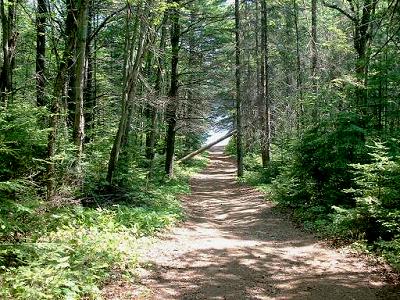
I put on my backpack and started up the portage. About 150 meters up, the path split. The trail to the right had a portage sign on it with an arrow pointing up the hill, so that was the route I took. After walking it for about 300 meters with water on both sides of the hill, it dropped back down towards the left and there was a canoe landing. So I dumped my pack. Went back and took the other path with the canoe and paddled it to where I had left the pack. Then staggered the carries on to Proulx. Photo : The portage to Proulx is also a cart path. The portage was an easy one over what is obviously a route designed to allow carts. It was threatening rain so I put on my rain pants. Since there was a bit of a head-wind, I decided to use my kayak paddle to get across Proulx. Still no rain by the time I reached the start of the river leading to Little Crow and switched to my regular paddle. About a third of the way into the river I heard the first thunder. There was nothing but bog everywhere so I figured mightas well keep going till I find a spot with solid ground. It had started to rain and the thunder was closer. I came to a good sized beaver lodge and decided I could unload on top of it and turn the canoe over on me and the pack and wait for the storm to pass. When I stepped up on the lodge I could see that Little Crow was only about 3 minutes further so I continued on to the lake, got out at the first campsite and waited out the storm there. When the storm had passed I continued on to Big Crow and saw my first moose of the trip in the channel between the two lakes. Once I saw Big Crow I decided to camp on the west side near the north end because it looked to have the best structure for fishing. Photo : Entrance to the Madawaska from Proulx Lake ... I headed for the campsite nearest to the portage to Hogan hoping that it was available and found that not only was it available but so was every other campsite on the lake. After all the reports I had read I was surprised to find that there was no one else camped on this lake. I pitched camp. The site was heavily treed and sheltered and the mosquitoes were thick. I thought it might just have been due to the rain but no, the mossies were just thick. A good douse of muskol and a cigar kept them at bay while I set up the rope to hang my food bag and collected firewood for that evening. It was 6 pm, so I ate the Ceasar salad I'd brought for the 1st night .. along with some cheese and salsa rolled in a flatbread. Then, I went fishing. I managed to catch 11 speckles in about one and a half hours. They were spunky fish, but the biggest was still less than a pound. Still, it was fun. I had my evening coffee beside the fire, right at the waters edge to get away from the swarms of mosquitoes and I hit the sack about 9:30. Day 2 - Hogan Lake
Photo : Campsite on Hogan Lake. I was soaked with sweat by the time I finished the portage. But the wind, that had picked up while I was going through the bush, was blasting down the lake from the west and cooled me down pretty quickly. The water was pretty rough, so I checked the map again to determine if I could make it to the 3 campsites clustered at the group of islands, should I followed the east shore. I figured that once I got through the 1st bay. the islands would provide some shelter from the waves and wind . So I went for it.
I used the kayak paddle and kept the bow angled such that the wind was hitting on the left side of the bow and actually blowing me toward the shore. Once I got through the 1st bay the waves were smaller and I then went between the islands and the main shore to the campsite on the main shore. This was a beautiful spot with sandy landing for the canoe and a grassy spot to pitch the tent. There were several clearings at the site which I think was the remains of an old lumber camp. Because of the windy conditions I did not get a chance to fish Hogan so I explored the area a bit and found several spots where old pots, bowls and parts of equipment had been discarded. Photo : Some equipment parts on the Hogan site ... I read part of the Canadian Geographic magazine I'd brought with me and decided it was too windy to have a fire that night. I wasn't sure if there was anyone else on this lake because they probably would have stayed in there campsites as well, due to the winds. But, I didnít see anyone. Day 3 - La Muir Lake 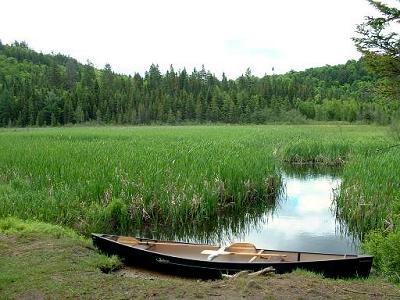
The wind was still blowing hard the next morning, but had switched and was coming more from the north. I figured I could make it to the river for the La Muir portage if I went along the back of the islands and then across the ľ mile of rough water to the west shore. While I was getting my morning coffee ready, I heard something walking in the water along the shore and before long a moose came into sight. It walked right past my canoe and tent without much notice. I packed up and made it safely to the portage to La Muir. This was again a cart path with the portage and cart path splitting for a while a short distance from the La Muir landing. Photo : Looking back at Madawaska River from portage to La Muir. The parks people have built a new landing/dock at the La Muir end. It is cedar log and a true work of art. I am constantly amazed by the amount of work that is done on the portages and interior campsites in the park. 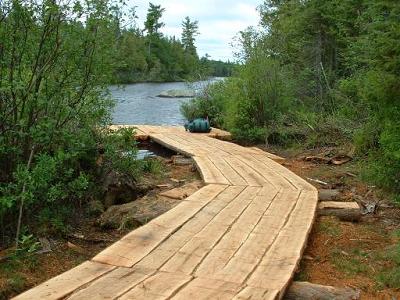
There was an Osprey nesting right across from the put in but the parent would not show herself for a picture. The small bay before the main lake has a small island which had gulls and great blue herons nesting on it. I was going to try and get a picture of this but the wind was blowing pretty hard and I knew if I let up on paddling I would get blown to the opposite shore so I passed up that opportunity. Photo : New landing built at La Muir end of portage ... ... Because of the wind I followed the north shore and fished my way along to the group of three campsites at the west end of the lake. I didn't get a strike until just past the entrance to Presquí ile Bay. It turned out to be a nice Speck of about 1.5 lbs. Got another one about the same size just before the first of the three campsites. Although the first two campsites looked pretty good I opted to stay at the last site. It had a nice sandy landing area for the canoe and the site was perched about 30 ft above the lake with a great tent site and fantastic view. In addition the previous tenants had left a good supply of wood for the fire. The fishing in the small bay in front of the site turned out to be pretty good. I got quite a few good specks and one small laker on La Muir .. a nice lake with beautiful clear water and again, not a soul in sight. The next morning and the wind had come up again. But I figured at least this was the day that I would start heading toward the south-east after Burntroot Lake. So I expected to have a tail wind for most of the day. Wrong! It turned out the wind had switched and was now out of the south-east. So I had a tail wind on La Muir to the portage, would have one on part of Burntroot and then a head wind. I trolled a lure along the shore to the portage but did not get anything. 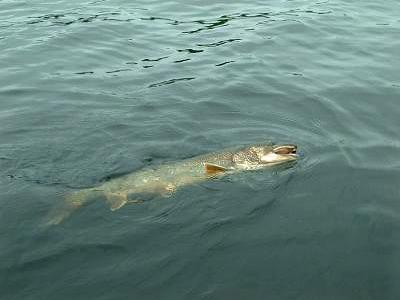
The portage to Burntroot has a steep section in it where there are actually steps made in the hill, to help in climbing the grade. The mosquitoes on this portage were rather thick, especially at the landing at Burntroot. With the wind coming from the south, the water on Red Pine Bay (donít know why it has that name cause there does not appear to be any significant amount of red pine there) was smooth as glass. I decided to fish my way through Burntroot following the north shore. I was almost out of Red Pine Bay when I got a hit that just screamed off line. This fish really put my 8lb line to the test. It took a good 5 minutes to get it to the boat. When it did come in, I noticed it had inhaled my cleo lure. I managed to get my needle nose plyers down into its mouth and unhook the lure and safely release the fish after a short recoup session. Photo : Laker I caught on Burntroot, about 8 lb.
I want to point out here that I fish barbless (pinch all the barbs down on my lures and leave only two hooks on a lure that comes equipped with a trebble). The two hook thing is because I think the 2 hooks look like a fish tail on the lure and whether true or not I think it makes for a more realistic look. Anyway had it not been for going barbless I would not have been able to extract the lure without doing serious damage to the fish so I would either have lost a good lure or had the fish die or both. However all worked out well and a healthy fish that I estimate to be a good 8 lbs is still swimming in Burntroot Lake.
That was all the fish I got in Burntroot but Iím not complaining. I then had to portage two short rapids which could easily be run if coming from the other direction. Then, I got into the Longer Lake section and luckily the wind died down. I did the 300 meter portage from Longer Lake to Big Trout and paddled along the north shore of Big Trout, toward the steep shore on the first large peninsula and started fishing. I'd decided to try and get a campsite on the large island at the north east end of the lake. On my way to the island I caught two fish that looked like overgrown Chub or Coy. I have yet to get the exact identification but I will. Each fish weighed about one and a half lbs. and hit on a cleo. Photo : One of the giant chub ... Editor's note: Fallfish (Semotilus corporalis) close to 24" / 2 lb. I chose the campsite on the north end of the island. There are some pretty impressive trees on this island. I went fishing again in the evening and got another one of these chub-like fish and nothing else. Next morning I packed up and decided to fish my way to the river. And, yes! I got yet another of these large chub-like fish. There must be a significant number of them in this lake. Got no trout in Big Trout which I thought was rather ironic. Again, there was not another person on this entire lake.
Day 5 - Merchant Lake It was a really muggy day when I headed out of Big Trout and the wind had died right down. I paddled into the river and after a lift over the only beaver dam that I encountered on the trip, reached the portage to Merchant. Itís a hefty portage with some noticeable hills in it. Photo : The only beaver dam on this trip. Merchant had crystal clear water. I'd planned to fish along the north shore toward the two campsites that were at the opening toward the Chickaree Lake portage. However, I quickly opted to go along the south shore when I saw the flat shoreline on the north and the hills on the south. This was further confirmed when I went a ways along the north shore and could still see bottom when I was about 200 meters from shore. I caught a couple of small lakers along the south shore and decided to stay on the campsite that was furthest east on the lake. Neither of these sites is particularly great and neither has got a canoe landing. But the one I chose did have a better tent site. 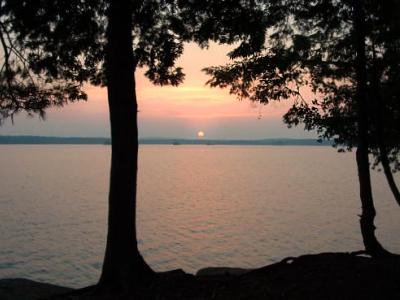
Later in the day, while sitting contemplating the world around me, I noticed what looked like a grouse settled fairly close to the thunder box. She was sitting under some balsam bows that had been cut and discarded in a pile, presumably to clear the path to the box. I figured the bird must be on a nest and decided to head back up with my camera to get a close-up shot. I approached as close as I dared without scaring the bird off and got ready to get my picture. When I crouched down to get the shot, I guess the bird figured I was now small enough for it to tackle. It arose off the nest and charged at me. Photo : One of my Merchant Lake sunset shots. I immediately jumped up to a standing position and the bird went after my ankle and gave it a good peck before backing off. She then spread her tail and hissed and growled in the same manner that tomcats do when they square off to fight. I took a picture of the nest, and a couple of shots of her and headed back down the hill with the bird still taking runs at my ankles. When I got down toward the tent, she finally backed off. I had no idea that Ruffed Grouse could be so protective and make those kind of noises. I had an amazing sunset that night and tried to get some shots of it after a bit more fishing. Again there wasn't another soul on this lake.
Day 6 - Happy Isle Lake Next morning was still muggy. The lake was like glass so I grabbed a quick coffee and was on the water fishing by 6 am. I got a couple more small lakers in the 2 lb range. I then decided to try Chickaree Lake. I found that there was pretty little waterfall on the small creek that runs out of Chickaree into Merchant. Chickaree is small but it does have some depth. I saw fish surfacing for bugs but didn't catch any. Photo : Shoreline on Chickaree Lake ... I packed up around 1pm and headed for the portage to Happy Isle. The portage is short and a well worn path.
I decided to fish along the north shore, even though the south shore looked better .. my thinking being that since the wind was down I could camp on the south shore and fish it that evening. When I was about half way down the lake, the wind came up out of the south-west and I could see some nasty clouds coming in. I decided to head for the campsite on the south shore .. closest to the portage to Opeongo, incase the wind did stay up the next morning so I would have no problem getting out. Photo : Looking at the portage to Opeongo from camp on Happy Isle. The campsite was well sheltered. It had a large hill behind it and a very small spot for a single tent. But it would do. While I pitched the tent, it got nasty. I hauled the canoe up into the sheltered area and turned it over. I walked out onto the few rocks and log out in the water to get a look down the lake. I could see and hear a wall of rain coming towards me. I grabbed the backpack and threw it and my boots under the fly and got into the tent and waited out the storm, which lasted about an hour. Even afterward, it still looked like more rain. So rather than fish, I opted for a dinner of roasted-garlic mashed potatoes, salsa and a grilled cheese. Then I spent some time reading before calling it a day.
Last Day I'd decided that I'd hit the portage to Opeongo by 9:30 that morning, to give myself enough time for an easy walk out, along with some time to clean up a bit while I waited for the taxi. Photo : He was using the portage, but let me by ... About 6:30 I heard a canoe coming from the portage. Two people in it and one of them was talking up a storm. As they passed by we exchanged waves and I noticed that this canoe had all the gear loaded in the bow. The first person was seated backwards in the canoe and he was using two canoe paddles that were somehow rigged to the gunnels like oarlocks and he was rowing the canoe like a rowboat. The guy seated in the stern didnít have a paddle and just sat there jabbering up a story. Quite an efficient use of manpower .. obviously dreamt up by the guy sitting in the stern. Again, it was muggy and hazy. It looked like possibly more rain but it was calm. So, after packing and loading up the canoe, I spent an hour fishing the south shore . It was just my luck that had to pack a damp tent on the last day. I managed to catch 3 lakers before heading for the portage.
Photo : Jimmy arriving with my Opeongo taxi. I finished the portage about 11:30 am. I'd arranged for the water taxi to pick me up at 1 pm. I hadn't originally planned to use the taxi to get out. However, when I was asked what time I wanted to be picked up at the Happy Isle portage, I figured it would just be my luck that if I turned it down, I'd end up windbound for the whole day up there. So I'd opted for the first time ever to use the taxi for my trip out. The bay on Opeongo where the portage ends was like glass. I cleaned up, put on the clean T-shirt I'd brought along and entertained myself by feeding a chipmunk and watching a cow-moose and her small calf walk through the marsh at the north end of the bay. The taxi arrived at 10-to-1. We loaded-up and headed-out. To those people who think Algonquin is too crowded .. I went through these lakes and did not see a single person on any lake for 5 days. I loved it! Again, my hat is off to the people who work in this park. They do an amazing job of making the portages a pleasure to use and of preparing the campsites. Opeongo Outfitters is a classy operation and I would recommend them in an instant. To anyone considering doing this loop .. if I were to do it again, I'd start at Happy Isle and go that way to Proulx. This would provide more of a downhill grade on most of the portages. Although I've been on Opeongo the past 2 years, it had been 4 years since I was on its north arm. I noticed that one of the small islands in the north arm had all but one of its trees killed. Turns out that Cormorants are the cause, as they moved in 3 years ago. I hope something is done to stop this invasive species from causing further destruction in Algonquin Park. |
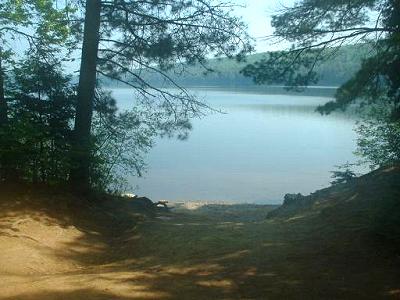 Me .. "Yeah, why?"
Me .. "Yeah, why?" 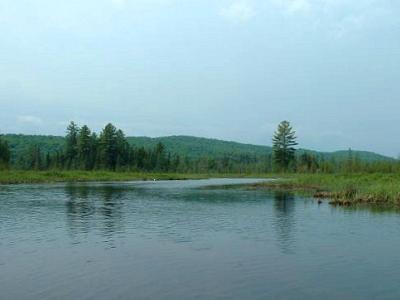
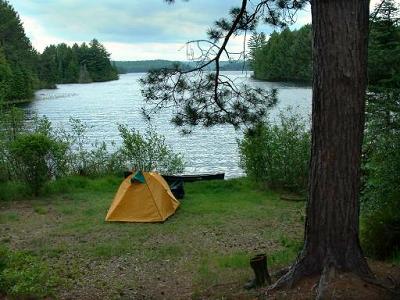 It had been a warm humid night and the morning was the same. The portage to Hogan shares the cartpath at first and then the portage spits off straight up a hill. The cartpath follows a more sane but presumably longer route. The portage then crosses the cartpath again (on an uphill climb of course) and then heads down hill to Hogan Lake.
It had been a warm humid night and the morning was the same. The portage to Hogan shares the cartpath at first and then the portage spits off straight up a hill. The cartpath follows a more sane but presumably longer route. The portage then crosses the cartpath again (on an uphill climb of course) and then heads down hill to Hogan Lake.
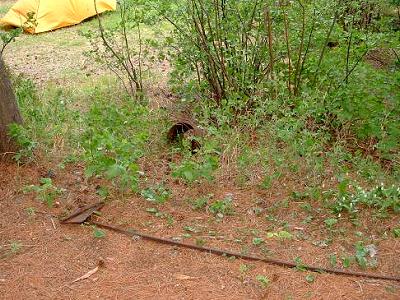
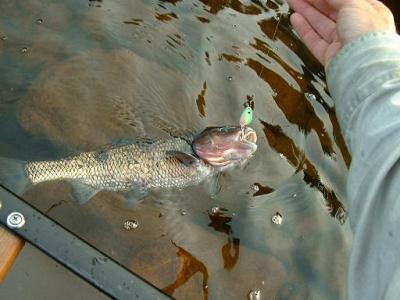
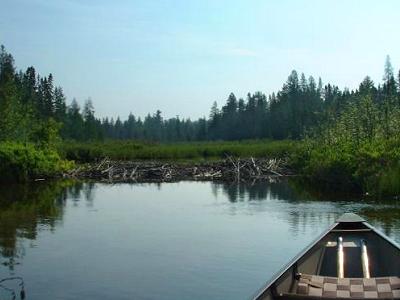

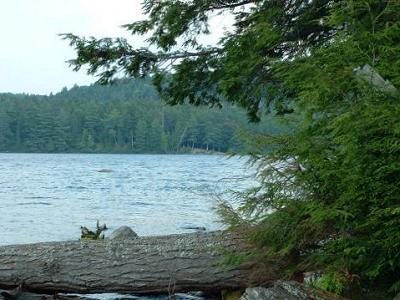
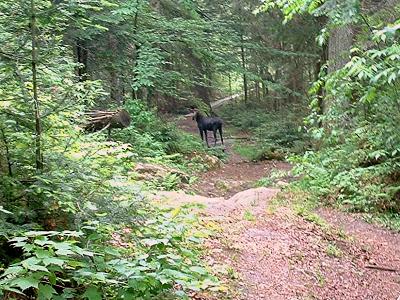
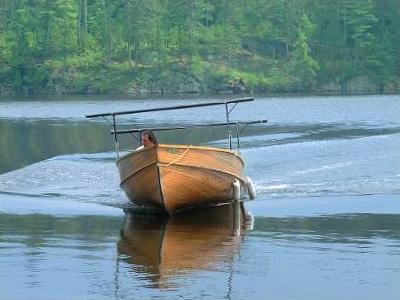 There's a nice beach landing at the start of this portage. Although there are some good hills on the portage, the climbs are gradual. So it makes for an easy pace. At a spot well over half way along the portage, I was carrying my pack and had my camera around my neck, when I came over a hill and saw a moose on the portage up ahead. He hadn't noticed me yet. I got the camera ready and made a fake cough. He stopped and looked my way. I got a couple of pictures and then he politely walked off the path into the bush.
There's a nice beach landing at the start of this portage. Although there are some good hills on the portage, the climbs are gradual. So it makes for an easy pace. At a spot well over half way along the portage, I was carrying my pack and had my camera around my neck, when I came over a hill and saw a moose on the portage up ahead. He hadn't noticed me yet. I got the camera ready and made a fake cough. He stopped and looked my way. I got a couple of pictures and then he politely walked off the path into the bush.